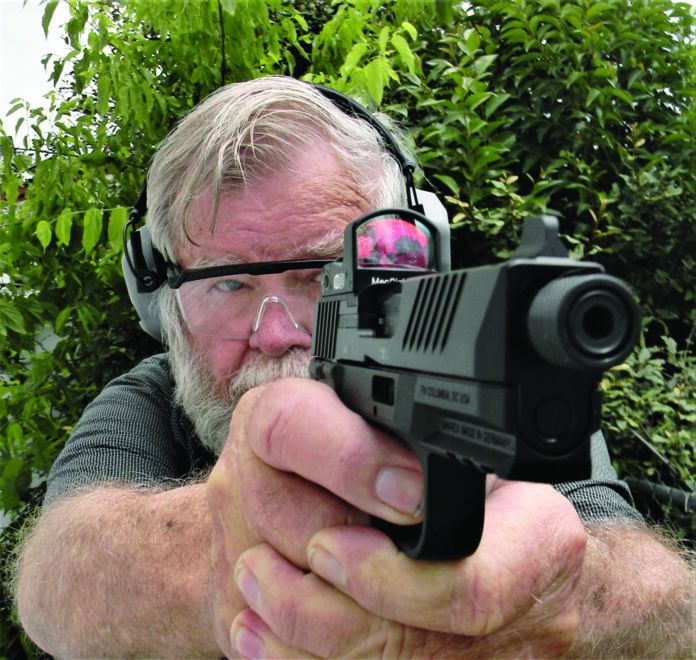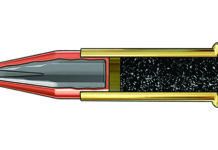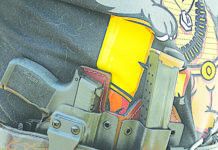We recently had a chance to compare two red dots you might consider for use on your firearms. The firsts contestant was Ruger’s ReadyDot, a $100 Ruger-branded optic designed for use with Ruger’s optic-ready pistols and other handguns using the Shield RMSc footprint. The second was Meopta’s Meosight IV 3-MOA Red-Dot Sight 1047103, $400. Here’s what we thought of them:
Ruger ReadyDot Optic 90742
Gun Tests Grade: D
$100
This was a recent price at Ruger.com. The ReadyDot doesn’t use batteries. Like the original Weaver Quik-Point Model S1, the ReadyDot utilizes ambient light and fiber optics to provide an aiming point. Red-dot sights for handguns are popular, and the Ruger optics-ready pistols are among the best combination of affordability and reliability. An affordable red dot for these handguns is the goal.
Properly used with both eyes open and trained behind the sight, red-dots increase speed to an accurate hit, rapidity of follow-up shots, and may even increase the shooter’s ability to connect at longer range. Our initial evaluation of the Ruger ReadyDot resulted in as many demerits as merits.
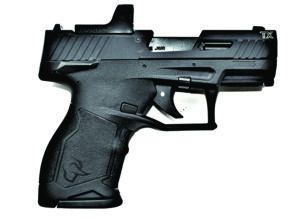
The most obvious drawback is that there is no means of adjusting the zero. For most Ruger pistols, the point of aim and point of impact may have a correlation close enough for close-in defense. We have always preferred to properly zero a defensive handgun. Fixed iron sights on modern handguns are usually zeroed for one range or another, usually 10 yards, and we expected at least this type of utility. But the ReadyDot isn’t adjustable for windage or elevation. Still, co-witnessing the dot with conventional sights is possible with some combinations.
The fiber optic is designed to gather and reflect light. The dot is fairly large, on the order of 15 minutes of angle. This is a large dot, and there is no adjustment for dot size or intensity. When used in different environments, a conventional battery-powered red dot may be adjusted for low or high light conditions. This dot can’t be manually adjusted to make it dimmer or brighter.
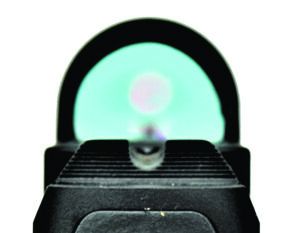
Ruger claims there’s an automatic brightness adjustment, so we mounted the ReadyDot on a Taurus TX22 22-caliber pistol that had proven to be accurate with its onboard sights.
We removed the TX22’s plate and added the Ruger ReadyDot in a few minutes time. Those who use a red-dot sight realize the lens is coated to reflect the red dot. In this case, coating gave the lens a well-defined blue shift.
After mounting the ReadyDot, we first explored differences in brightness. Inside a home with normal lighting, the large dot was properly illuminated for inside use. Outside, the dot was brighter, which is considered superior for outdoors use. The changeover was instantaneous, so the Ruger ReadyDot did prove to be self adjusting.
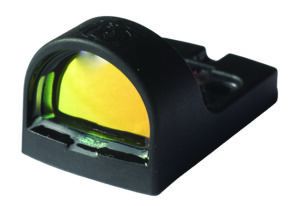
However, in darker conditions, such as an unlit back yard or dim bed room, the dot disappeared. Mounting a combat light and then using the dot in the flashlight beam did not help. To us, the best combination of aiming occurs when the target and the red dot are in the same light conditions.
On the upside, the ReadyDot doesn’t suffer from the familiar starburst effect in bright light. It actually offers a solid aiming point in most outdoor scenarios. But home defense is serious business, and that nighttime to dim-light shooting is seriously curtailed is simply untenable, in our view.
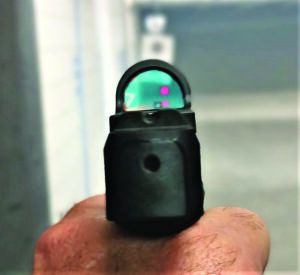
We also checked sight alignment, since adjustment is unavailable. We fired the Taurus TX 22 and Ruger ReadyDot at 7, 12, and 25 yards using Winchester Wildcat 40-grain ammunition. At 7 yards, the point of impact was half an inch off to the right, with the groups centered for elevation. At 12 yards, the rightward point of impact had strayed from the aiming point by 2.0 inches and then 3.5 inch at 25 yards. At close range, perhaps the point of impact would not matter as much or could be accounted for in a personal defense situation. For target shooting and marksmanship, this was far from ideal.
On the other hand, because there is no battery compartment, the ReadyDot is quite compact. Also, during the firing test, the Ruger ReadyDot did not shift its point of impact.
Our Team Said: There are serious drawbacks to the Ruger ReadyDot. The device cannot be zeroed. We are probably lucky the sight was as close as it was with elevation on and windage off. In dim light we were able to identify the target but we were unable to discern a faint point of light in the sight. If you have additional funds to purchase a real red dot instead of the ReadyDot, you should. For occasional practice in mastering the red dot or to explore red-dot sights before switching over to this type of sighting equipment, the Ruger ReadyDot has some merit. Beyond that, we can’t see much use for it.
Meopta Meosight IV 1047103 Red-dot Sight
Gun Tests Grade: A
$400
The MeoSight IV red-dot reflex sight is Meopta’s lightest offering at 1.2 ounces, making it well suited for handgun use. We think the MeoSight is also well suited for use on long guns intended primarily for home defense or for use at modest ranges.
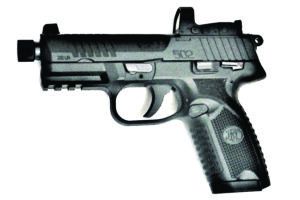
If mounted on a long gun, the supplied adapter for a Picatinny rail is used. The body is aluminum.
The MeoSight IV is intended to offer great speed and accuracy. The lens is scratch resistant, and the sight picture remains wide for such a compact sight. Meopta stresses the MeoSight IV was designed for good performance when firing on the move.
In common with other red-dot sights, this unit does not have any magnification. The dot is 3 minutes of angle (MOA), much smaller and precise than the Ruger’s.
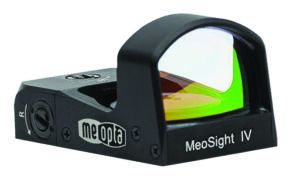
The MeoSight has a high degree of adjustment, with 120 MOA possible in elevation and windage adjustment. In common with most red-dot sights of this size and weight, power is supplied by a Cr1632 3-volt battery for 30,000 hours of battery life. The MeoSight has an automatic cut off after four hours of inactivity.
The MeoSight IV features both an automatic and a manual brightness setting. There are five light-intensity levels. We tested this extensively and can endorse that the levels are distinct and useful. The sight is supplied with a Picatinny rail mount and uses the Docter pattern.
To test it on a gun, we chose an FN 502 22 rimfire to parallel the rimfire use of the ReadyDot. One reason for mounting the MeoSight IV on the FN 502 was that the FN 502 rimfire, a threaded-barrel handgun, features large suppressor-ready sights. The use of a red-dot sight with these tall sights allows the pistol to be properly zeroed.

Our primary concern when testing red-dot sights is personal defense. You must draw the pistol, allowing the presentation to lead into a good shooting stance and a proper sight reference. It all occurs in the blink of an eye. A red-dot sight is an aid for those willing to invest time, effort, and range time in mastering the concept. An advantage of the red-dot sight is the things that are not done and need not be learned. Sight alignment, setting the light between the rear notch and front post, and closing one eye aren’t necessary steps. You fire with both eyes open.
In range testing, we found the MeoSight red-dot sight to be very fast and offer real speed and accuracy. Of course the raters had different ideas concerning light settings for various engagement distances, and the MeoSight allowed them to choose what they liked for distance and dimness.
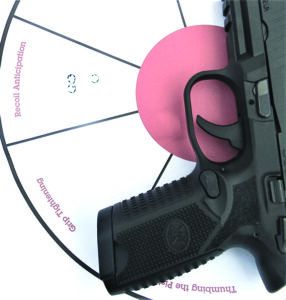
Moving from one target to another was very smooth, and moving targets were easily addressed. None of our experienced raters have ever bought into point and shoot with a handgun. We use our sights. In this case, point-and-shoot firing using the red dot is very fast and very accurate. Adjusting the red dot’s location with the supplied tool was simple enough.
We found the controls pressure switch easily applied: forward is positive and rear is negative, with the setting returning to the previous setting after the red-dot sight goes off on its own. When firing quickly offhand and once the pistol was sighted in, we found the 3-MOA dot is small enough for precise shooting but also makes for excellent speed. The red dot offers a good contrast against combat-type targets and practical applications we explored. As an example, following a moving reptile or rodent in the common use a 22 LR firearm is put to is easily accomplished. An important consideration is that when you are attempting to engage a moving target, firing with both eyes open allows you to anticipate movement and nearby cover and obstacles. While you may learn to fire with both eyes open with fixed iron sights, this isn’t as fast and accurate as the red-dot sight.
Our Team Said: The MeoSight IV sight is easily adjusted for zero and for dot brightness. We enjoyed using the sight. Our evaluation is that the MeoSight IV is a good to very good red-dot sight. Perhaps prices for the sight will come down and make it more affordable.


























